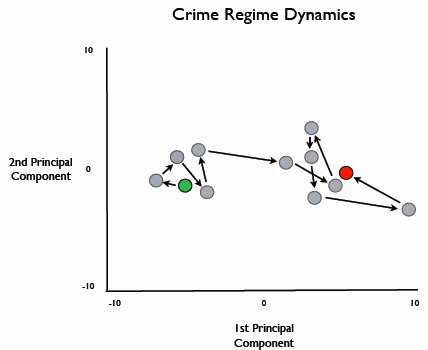The Atlantic, By Nadya Labi, Jan 2012
Richard Berk likes to think he knows what criminals will do-even before they know. The statistics professor, who teaches at the University of Pennsylvania, was recently willing to show off his skills. "What is the highest-risk age for re-offending?" he asked. I hazarded the early 20s, and was quickly corrected.
"Teens," he responded. "Actually, the [rate of re-offending] falls off very quickly in the early 20s." But the trend line doesn't hold, Berk explained. Violent activity starts to increase again in individuals a decade or so older. "You're picking up the domestic-violence offenders," Berk surmised. "They need someone to beat up on, and they're in their late 30s."
This sort of behavioral analysis is at the center of Berk's expanding work as something of a crime predictor-a number cruncher whose algorithms are helping police and corrections officials forecast recidivism. The Pennsylvania Board of Probation and Parole, for instance, has been working with the professor for the past two years.
...
Drawing from criminal databases dating to the 1960s, Berk initially modeled the Philadelphia algorithm on more than 100,000 old cases, relying on three dozen predictors, including the perpetrator's age, gender, neighborhood, and number of prior crimes. To develop an algorithm that forecasts a particular outcome-someone committing murder, for example-Berk applied a subset of the data to "train" the computer on which qualities are associated with that outcome. "If I could use sun spots or shoe size or the size of the wristband on their wrist, I would," Berk said. "If I give the algorithm enough predictors to get it started, it finds things that you wouldn't anticipate."
Philadelphia's parole officers were surprised to learn, for example, that the crime for which an offender was sentenced-whether it was murder or simple drug possession-does not predict whether he or she will commit a violent crime in the future. Far more predictive is the age at which he (yes, gender matters) committed his first crime, and the amount of time between other offenses and the latest one-the earlier the first crime and the more recent the last, the greater the chance for another offense.
Read more.
Here is Richard Berk personal page.
This graph shows movement of crime regimes over time, in the space of 2 principal components,

and is explained in this research paper
The Dynamics of Crime Regimes, by Richard Berk and John MacDonald, UPenn, 2009.
Abstract:
Crimes have many features, and the mix of those features can
change over time and space. In this paper, we introduce the concept
of a crime regime to provide some theoretical leverage on collections
of crime features and how the collection of features can change. Key
tools include the use of principal components analysis to determine the
dimensions of crime regimes, visualization methods to help reveal the
role of time, summary statistics to quantify crime regime patterns, and
permutation procedures to examine the role of chance. Our approach
is used to analyze temporal and spatial crime patterns for the City of
Los Angeles over an 8 year period. We focus on the number of violent
crimes over time and their potential lethality.
